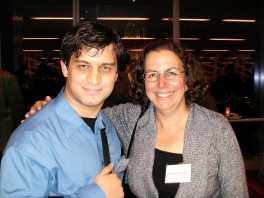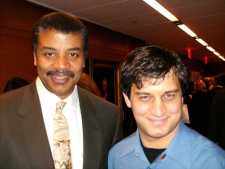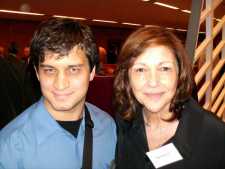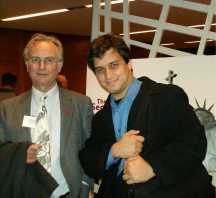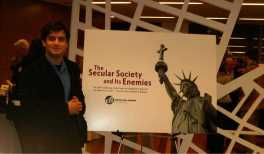I mentioned back in October that this weekend I’d be attending The Secular Society and Its Enemies, the 2007 conference of the Center for Inquiry. I didn’t get to post my report on the first day of the conference yesterday (since it finished rather late), so I’ll do that now. My report on today’s events will be up tomorrow, and Sunday’s report will be posted on Monday.
The conference was held at the New York Academy of Sciences in lower Manhattan, which is on the 40th floor of World Trade Center 7. The conference center’s windows held a stunning panorama of New York City, and – not coincidentally – a breathtaking perspective on Ground Zero. That place, in the shadows of the absent World Trade Center, was a fitting site to discuss our secular society and the threat it faces today from the forces of fundamentalist zealotry.
The conference opened with a cocktail hour and informal reception. Quite a few of the leading lights of freethought, renowned intellectuals who would be speaking at later events, were there that night. While circulating through the room and chatting, I had the opportunity and the privilege to meet and speak with some of them, and many graciously consented to pose for pictures.
First, here’s me with Lori Lipman-Brown, director of the Secular Coalition for America. (When I greeted her with “Hi, Lori!”, she said cheerily back, “Hi, Adam!” – and I was stunned until I belatedly remembered my name tag.) We spoke briefly about church-state issues, and she had good news: Republican Senator David Vitter’s disgraceful earmark to a creationist group was defeated. (Unfortunately, she also said Senator Tom Harkin backed off on an earlier pledge to oppose federal funding for abstinence-only sex education. Can’t win them all, I suppose.) When I asked if the SCA had turned up any new nontheist congresspeople since Pete Stark, she said that there was at least one other known to her, and that she was trying to get that one to come out of the closet. Of course, the SCA doesn’t out anyone against their will, so that congressperson’s identity is still a secret for now.
This next picture is going to make a friend of mine very jealous, which is all I’ll say about it – other than to add, if you were ever curious, that Neil deGrasse Tyson has an iPhone. 🙂
Here’s one of me with Ann Druyan, Carl Sagan’s widow and a superb author and speaker in her own right – more on that later.
And finally, the piece de resistance. I’m afraid I was a bit of a starry-eyed fan – I couldn’t not be, he mentioned me in his book! – but Dr. Dawkins was extremely polite and gracious in consenting to be photographed with me.
Finally, one of just me at the conference entrance:
I should note that I also met D.J. Grothe, host of Point of Inquiry – don’t have a picture of that, sorry. But it was a civil meeting, and despite our past differences, we got along well. And yes, I still do listen to Point of Inquiry and encourage others to do so.
After opening remarks by Paul Kurtz, chairman of CFI, the major event of the first night was a birthday tribute to Carl Sagan (November 9 was his birthday), presided over by Ann Druyan and Neil deGrasse Tyson. Dr. Tyson led off with an astonishing story.
Even as a high-school student, he dreamed of pursuing a career in astronomy. Upon graduation he applied to Cornell University, and his entrance essay referenced the Cosmos TV series. One of Cornell’s admissions counselors passed the essay to Carl Sagan – who read it and then wrote the 17-year-old Tyson a letter inviting him to come to Cornell for a personal tour of the campus!
After the visit, it was snowing heavily. Sagan dropped Tyson off at the bus stop, but the arrival of further buses seemed in doubt. So, Sagan wrote his home phone number on a piece of paper and gave it to Tyson, leaving him with the advice that if the bus didn’t come, he could call and spend the night at Sagan’s house. After recounting this story, Dr. Tyson said that ever since, he’s always tried to treat students who came to him as he was once treated by Carl Sagan.
There were more than a few damp eyes in the house, and I can say without any shame that mine were among them.
The conference organizers next played a rare audio recording of Sagan reading the famous passage, Reflections on a Mote of Dust, from his book Pale Blue Dot. Afterward, Ann Druyan (who was more than a little choked-up herself, and who could blame her?) took the stand to speak of Sagan’s legacy. She said, in a speech I hope always to remember, that the word “supernatural” is a terrible misnomer. Instead, she said passionately, we should call it the “subnatural”, because even the most elaborate imaginings of humans pale beside the majestic glory of the cosmos as it is revealed to us, and that communicating that sense of awe and wonder was what Carl Sagan did so well. Even today, over ten years after his death and over twenty years after Cosmos was first broadcast, it’s never gone off the air, and it’s still one of the most beautiful and compelling scientific documentaries of all time.
The event closed with CFI presenting the 2007 James Madison Award for Religious Liberty to Matt LaClair, the New Jersey high school student who adeptly exposed the outrageous religious bullying of a popular public school teacher. Matt, who was in attendance with his parents, was a wonderful speaker, and delivered a well-written and gracious acceptance speech with humility and poise. As I’ve said previously, I think we can expect great things from him.
All in all, the conference so far has been a fantastic event and a wonderful opportunity for freethinkers to meet and work together. Much gratitude is due to CFI for organizing and sponsoring it. More to come tomorrow – stay tuned!
